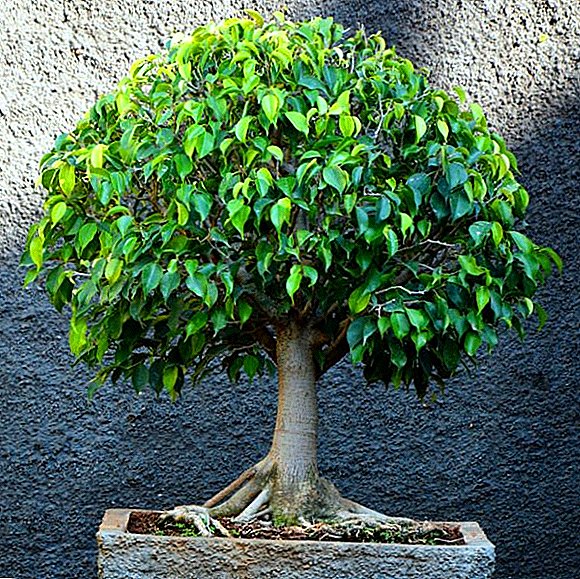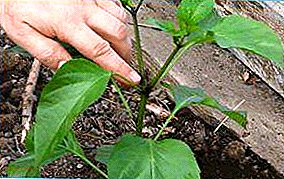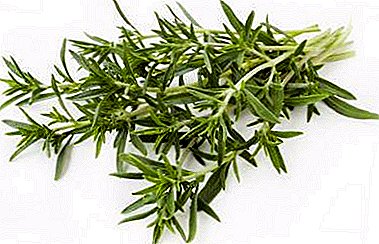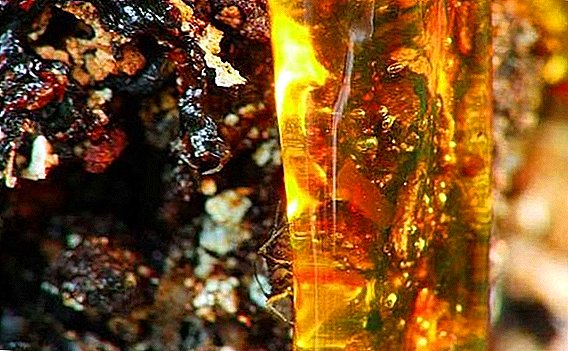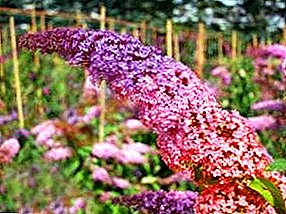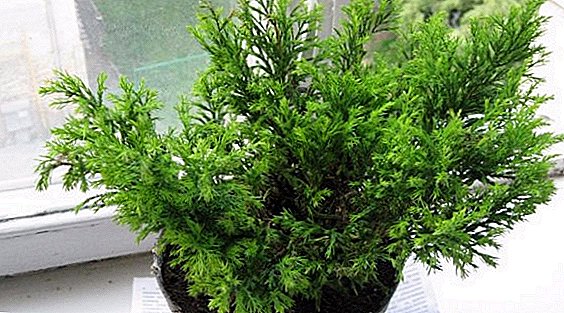 Cypress is an excellent “forest substitute”, which can be grown both in the room and on the site. The aroma that comes from this little tree reminds of walks in the fresh air in coniferous forests. Cypress - an evergreen plant, a representative of the genus cypress. It has two crowns: sprawling and pyramidal. In our time, the species has 14-25 varieties.
Cypress is an excellent “forest substitute”, which can be grown both in the room and on the site. The aroma that comes from this little tree reminds of walks in the fresh air in coniferous forests. Cypress - an evergreen plant, a representative of the genus cypress. It has two crowns: sprawling and pyramidal. In our time, the species has 14-25 varieties.
Did you know? The plant got its name from the legend of the young man Cypress, who killed the horse of Apollo, and for this offense, profit was doomed to live in the form of a tree.
An adult tree can reach 25 meters in natural conditions, and in domestic or indoor trees, of course, it is smaller in size. Today we will talk about what to do if the cypress dries up and how to prevent it.
The main mistakes care cypress
Cypress dries more often because of improper care. The homeland of cypress is considered to be the Mediterranean. Therefore, in order for the cypress to feel comfortable in your home, it is necessary to provide it with a warm, moist place.
Lighting and temperature
 As already noted, the cypress loves heat, but the temperature should vary depending on the season. In the summer, the adult plant feels most comfortable at a temperature of 20-30 degrees, and in winter the temperature should be reduced to a few degrees with a "+"
As already noted, the cypress loves heat, but the temperature should vary depending on the season. In the summer, the adult plant feels most comfortable at a temperature of 20-30 degrees, and in winter the temperature should be reduced to a few degrees with a "+"
Important! Cypress does not need direct sunlight. Even if you grow it on a plot, and not in a room, it is better to plant it in light shading.
In order for the cypress in the room to feel comfortable and the branches did not dry out, it is better to place it so that the lighting is bright but diffused.
Watering and feeding plants
Cypress need to be watered properly, maintain sufficient humidity and fertilize the plant competently. Since cypress grows in wet places and often near water bodies at home, it is also necessary to provide good moisture to the house. If the cypress begins to dry, it lacks water. Therefore, the plant is sprayed with warm water or periodically "bathed."
 Watering is necessary as it grows:the older and more advanced the root system, the more water it needs, therefore, when the top layer of the substrate dries out, the cypress is watered. If it is summer outside, water more; in winter, less. The main thing is not to overflow, because a humid environment is a great place for the development of fungal diseases.
Watering is necessary as it grows:the older and more advanced the root system, the more water it needs, therefore, when the top layer of the substrate dries out, the cypress is watered. If it is summer outside, water more; in winter, less. The main thing is not to overflow, because a humid environment is a great place for the development of fungal diseases.
If you notice that the cypress is showered, and do not understand what you did wrong, you should think about whether you fertilize your plant properly. For fertilizer, it is better to use top-dressing based on mineral substances, and not those that contain a large amount of nitrogen (it can dry out the roots). Do not use liquid fertilizer in the summer when spraying.
Pruning errors
Cutting cypress is necessary for the rejuvenation of plants and the prevention of disease, as well as simply to give them a new, more decorative look. Error when pruning - in the first year to cut too many branches that do not have time to recover. You need to cut off gradually, removing all the yellowed branches, old shoots, as they do not let in light. It is necessary to use only a sharp pruner and make it fast and sharp movements. 
Cypress dries after transplanting
It often happens that the cypress dried up after transplantation. What to do to this did not happen.
Replacing the cypress too often should not be enough transplant as it grows. Replant the plant better in a warm season. Even if it was bought in the winter, it is better to transfer it in the spring. Often the cypress dries after transplanting due to the fact that the roots were damaged during the extraction from the pot.
Did you know? In order not to damage the root system during transplantation, a pot of cypress can be put in the water. The soil will get wet, and the plant will easily slip out of the previous "place of residence".
It is important to plant the plant in a new pot: the root neck should not be completely in the ground, because it contributes to the death of the plant.
Cypress diseases, all about treating plant afflictions
 As we already know, cypress is grown as a houseplant and as a plant for the street. Most often, cypress disease occurs as a result of improper care.
As we already know, cypress is grown as a houseplant and as a plant for the street. Most often, cypress disease occurs as a result of improper care.
Fusarium
Fusarium is also known as tracheomycosis - a disease that begins with the decay of the roots, and then affects the entire plant.
Important! If the shoots of your cypress have turned yellow, and the bark of the stem has become a rich drilling color - this is a clear sign of fusarium.
Very often, the disease is already laid in seedlings, seeds, or can be stored in the soil. The best prevention of this disease will be timely airing and loosening the soil, you should also disinfect all the material and tools that you use in working with plants.
Most often, the diseased plant cannot be cured, in which case it is simply uprooted and disposed of. If it is affected by less than 60%, you can try to save it by rooting the cutting. For cuttings usually choose the top shoot, process it with "Fundazole", leave for eight hours in its solution with a small amount of the drug "Appin". If the cutting has taken root, the disease has passed. By the way, "Fundazol" is also great for the prevention of Fusarium.
Brown shutte
Brown shyutte is a typical disease for conifers. Most often it appears on young plants immediately after the snow melts, when the plant is still very weak. External signs are the darkening of the plant and the bloom, like a web. This disease loves shade and waterlogging. For treatment, you must use lime-sulfur preparations - "Abiga-Peak" or Bordeaux mixture. Spraying is carried out in the spring and must be repeated in the summer.
Fungal diseases
 Fungal diseases can lead to wilting and drying out of branches, damage to the bark. In order to avoid fungal diseases, it is necessary to remove dead shoots in time, loosen the soil and remove fallen leaves (if we are talking about street cypress) from under the plant, because most of the mushrooms live in such places. After you remove the diseased plant, it is necessary to treat the soil and nearby plants with the preparation "Abiga-Peak" or Bordeaux mixture.
Fungal diseases can lead to wilting and drying out of branches, damage to the bark. In order to avoid fungal diseases, it is necessary to remove dead shoots in time, loosen the soil and remove fallen leaves (if we are talking about street cypress) from under the plant, because most of the mushrooms live in such places. After you remove the diseased plant, it is necessary to treat the soil and nearby plants with the preparation "Abiga-Peak" or Bordeaux mixture.
Did you know? If the cypress grows on the street next to deciduous trees, it increases the risk of plant disease.
Pests of outdoor and indoor cypress
In order for your plants to be protected from pests, you need to know exactly what parasites can live on your plant.
The main pests of indoor cypress
Cypress need to constantly "examine" for the appearance of pests on it and defeat them. Most often it is a plant louse, scythe and spider mite.
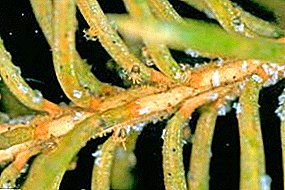 The presence of spider mites on your plant, you will notice if the white spider web appears on the branches. To combat it, use insecticides. For example, "Vermitek", "Actofit", "Fitoverm". You may need to reuse these drugs. Effective in the fight will be folk remedies such as soap solution.
The presence of spider mites on your plant, you will notice if the white spider web appears on the branches. To combat it, use insecticides. For example, "Vermitek", "Actofit", "Fitoverm". You may need to reuse these drugs. Effective in the fight will be folk remedies such as soap solution.
Important!Medicines for treating scythes have not yet been invented, therefore any means of fighting against indoor insects can be used to combat this insect.
A sinus sucks sap from the plant and the tree dries. Brown spots on the trunk - the first sign of the scale. The fight against this insect is in the treatment of soapy water and any of the insecticides. You can collect insects by hand, but do it with gloves.
Aphids are white insects that live on the inside of a leaf. It can only be destroyed with special preparations, the treatment of which will have to be repeated.
Street Cypress Pests
 The juniper scapula and seaside mealybug are very common. If you have noticed caterpillars on your bush, this is a sign of the bush being damaged by the butterflies of the silkworm and the juniper cow scoop. These insects damage the kidneys and cones. Insects can also harm the trunk and bark - this is the live beetle and bark beetle. If you notice beetles on your cypress, the branch damaged by this insect must be cut down and treated with a cut of oil paint. In order to destroy the bark beetles at an early stage, it is necessary to make injections into the bark of the drug "Aktelik". In May-June, the plants are treated with such drugs as "Fufanon" and "Profi".
The juniper scapula and seaside mealybug are very common. If you have noticed caterpillars on your bush, this is a sign of the bush being damaged by the butterflies of the silkworm and the juniper cow scoop. These insects damage the kidneys and cones. Insects can also harm the trunk and bark - this is the live beetle and bark beetle. If you notice beetles on your cypress, the branch damaged by this insect must be cut down and treated with a cut of oil paint. In order to destroy the bark beetles at an early stage, it is necessary to make injections into the bark of the drug "Aktelik". In May-June, the plants are treated with such drugs as "Fufanon" and "Profi".
In order for your cypress to exude health and cause you only positive emotions, it is necessary to properly care for it and protect it from all sorts of pests and diseases.


